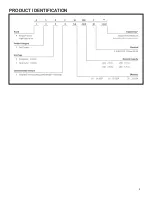
SYSTEM OPERATION
18
Communicating System
The communicating platform is a system that includes a
communicating air handler/furnace/modular blower and air
conditioner or heat pump. Any other system configurations
are considered traditional (or legacy) system.
A
communicating
heating/air conditioning system differs
from a legacy/traditional system in the manner in which
the indoor unit, outdoor unit and thermostat interact with
one another. In a traditional system, the thermostat sends
commands to the indoor and outdoor units via analog 24
VAC signals. It is a one-way communication path in that the
indoor and outdoor units typically do not return information
to the indoor board.
On the other hand, the indoor unit and outdoor system
“communicate” digitally with one another. It is now a
two-way communications path. The thermostat still sends
commands to the indoor and outdoor units. However, the
indoor board may also request and receive information
from the outdoor unit. This information may be displayed
on the Cool Cloud HVAC app.
Airflow Considerations
Airflow demands are managed different in a fully
communicating system than they are in a legacy wired
system. The system operating mode (as determined by
the thermostat) determines which unit calculates the
system airflow demand. If the indoor unit is responsible for
determining the airflow demand, it calculates the demand
and sends it to the ECM motor. If the outdoor unit or
thermostat is responsible for determining the demand, it
calculates the demand and transmits the demand along
with a fan request to the indoor unit. The indoor unit then
sends the demand to the ECM motor. The following table
lists the various communicating systems, the operating
mode, and airflow demand source.
For example, assume the system is an air conditioner
matched with an air handler. With a call for low stage
cooling, the air conditioner will calculate the system’s low
stage cooling airflow demand. The air conditioner will then
send a fan request along with the low stage cooling airflow
demand to the air handler. Once received, the air handler
will send the low stage cooling airflow demand to the ECM
motor. The ECM motor then delivers the low stage cooling
airflow. The table below lists the nominal high and low
stage airflow for the communicating air conditioners and
heat pumps.
High
Low
High
Low
*SZC160241
800
600
800
600
*SZC160361
1200
800
1200
800
*SZC160481
1550
1100
1550
1100
*SZC160601
1800
1210
1800
1210
*SZC180241
850
550
850
550
*SZC180361
1250
850
1250
850
*SZC180481
1750
1210
1750
1210
*SZC180601
1750
1210
1750
1210
Models
Cooling
Heating
Control Wiring
NOTE: Refer to section Electrical Connections - High
Voltage Connections for 208/230 volt line connections
to the air conditioner or heat pump.
NOTE: A removable plug connector is provided with
the control to make thermostat wire connections.
This plug may be removed, wire connections made to
the plug, and replaced. It is strongly recommended
that you do not connect multiple wires into a single
terminal. Wire nuts are recommended to ensure one
wire is used for each terminal. Failure to do so may
result in intermittent operation.
Typical 18 AWG thermostat wire may be used to wire the
system components. 100 feet is the maximum length of
wire recommended between indoor unit and outdoor unit,
or between indoor unit and thermostat.
NOTE: It is highly recommended that the fault history
be cleared.
Содержание ASXC16
Страница 4: ...PRODUCT IDENTIFICATION 4 ...
Страница 5: ...PRODUCT IDENTIFICATION 5 ...
Страница 70: ...SERVICING 70 PCBHR104 PCBHR105 ...
















































